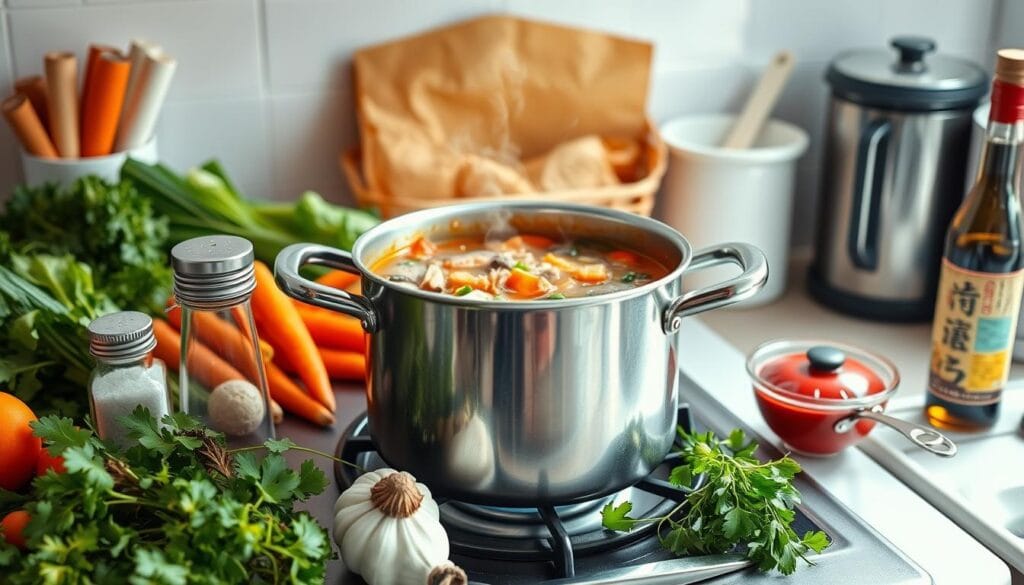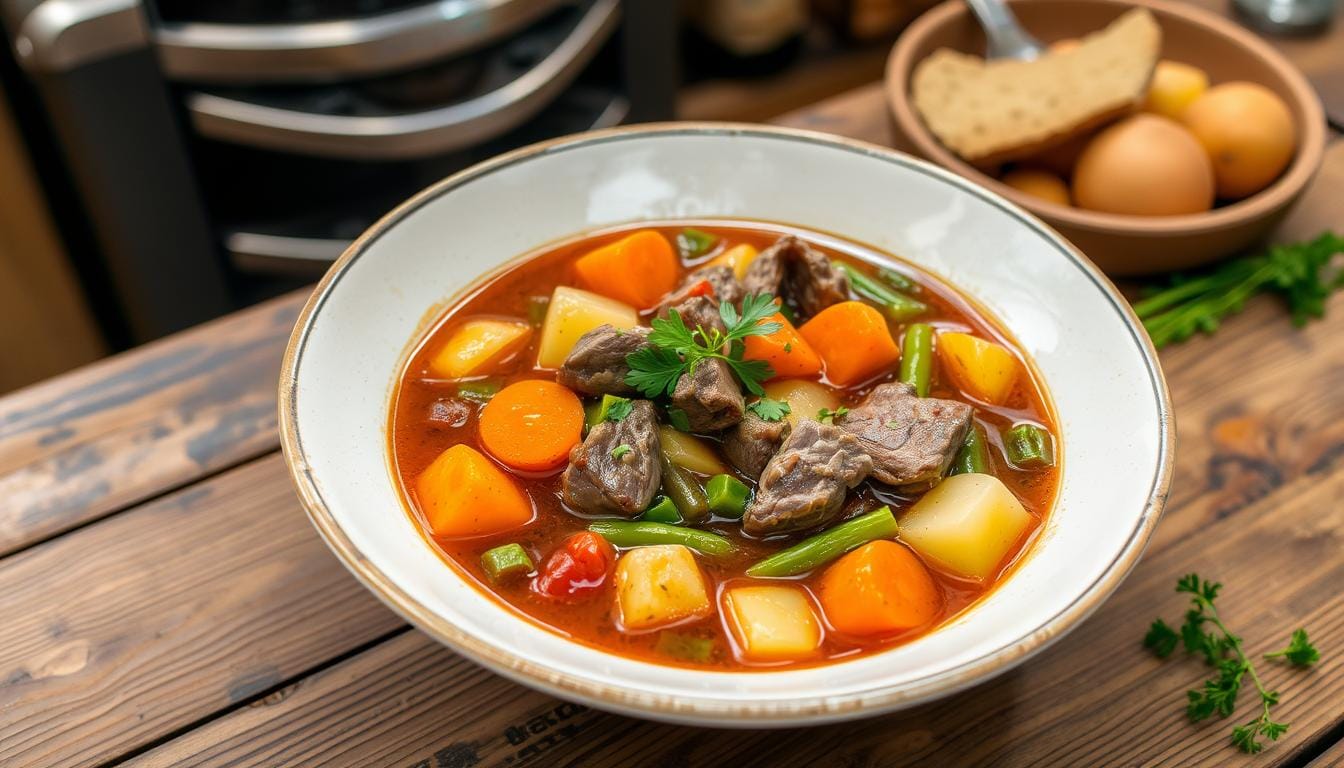Winter’s chill brings a craving for warm, comforting soup. But why does my vegetable beef soup taste bland? It’s a letdown, leaving you wanting that rich, savory taste. Don’t worry, I’ve got tips to make your soup flavorful and exciting.
This guide will show you how to make a vegetable beef soup that’s full of flavor. We’ll cover making a great broth and finding ways to make your soup even better. Get your ladle ready to make your soup delicious!
Understanding the Basics of Flavorful Vegetable Beef Soup
Making a tasty vegetable beef soup is all about balance. It’s about knowing how each ingredient adds to the flavor. From the beef’s savory taste to the fresh veggies’ sweetness, every bit counts.
Key Components of a Well-Seasoned Soup
A great vegetable beef soup starts with quality ingredients. The main parts are:
- Lean ground beef: Adds a rich, savory taste
- Fresh vegetables: Bring texture and natural sweetness
- Aromatic herbs and spices: Add depth and complexity
- Robust broth: Brings all the flavors together
The Role of Each Ingredient in Flavor Development
Each part of a vegetable beef soup has its own job:
- Beef gives a deep, umami flavor, making the soup hearty.
- Vegetables like carrots and potatoes add sweetness and texture, plus vitamins.
- Herbs and spices like garlic and oregano add complex aromas and flavors.
- A robust broth holds everything together, blending all the flavors.
Knowing how each ingredient works helps make a soup that’s both tasty and satisfying.
“The secret to a flavorful vegetable beef soup lies in the balance and harmony of its key components. When each ingredient plays its part, the result is a soup that warms the soul.”
Why Does My Vegetable Beef Soup Taste Bland?
If your vegetable beef soup tastes bland, there are several reasons. It could be from not enough seasoning or using low-quality ingredients. Finding out what’s wrong is the first step to making your soup taste better.
One big reason is not enough salt. Salt is key to bringing out the flavors of your ingredients. Without it, your soup will taste flat.
Another reason is cooking too fast. Giving your soup enough time to simmer is important. Rushing it can make it taste bad.
Not adding layers of flavor is another mistake. Skipping steps like sautéing onions and garlic can make your soup taste dull. Not adding ingredients like tomato paste or Worcestershire sauce also hurts the flavor.
Lastly, using bad ingredients can ruin your soup. Cheap beef, old spices, or soggy veggies can make your soup taste bad.
By fixing these common mistakes, you can make your soup taste amazing. It will be a rich, savory dish that you’ll love.
Why Does My Vegetable Beef Soup Taste Bland? Key Ingredients for a Rich and Savory Broth
Creating a flavorful vegetable beef soup starts with a rich, savory broth. This base is crucial for all other ingredients to stand out. You’ll need the right beef, fresh veggies, and quality stock to get it right.
Choosing the Right Cut of Beef
Chuck roast is the best beef for your soup. It comes from the shoulder and is known for its flavor and tenderness. Choose chuck roast, chuck shoulder, or chuck-eye roast for the best results.
Selecting Fresh vs. Frozen Vegetables
Fresh veggies make a better broth than frozen ones. Onions, carrots, celery, and garlic add depth to your soup. Chop them well to release their flavors.
The Importance of Quality Stock
A great vegetable beef soup needs a top-notch beef stock or broth. Using a rich, seasoned stock makes a big difference. Mix beef and vegetable stocks for a balanced taste.
| Ingredient | Quantity | Purpose |
|---|---|---|
| Chuck roast | 2-3 lbs | Provides rich, tender beef flavor |
| Fresh onions, carrots, celery | 1 cup each, chopped | Adds essential aromatics and flavor |
| Beef stock or broth | 8 cups | Serves as the foundation for the soup |
With the right ingredients and a flavorful broth, your vegetable beef soup will be rich, savory, and satisfying.
Why Does My Vegetable Beef Soup Taste Bland? Seasoning Techniques for Richer Flavor
To make a flavorful vegetable beef soup, you need to add herbs and spices wisely. It’s important to layer the flavors as you cook. This way, you get a mix that excites your taste buds.
Layering Herbs and Spices
Begin by cooking onions and garlic in the pot. This brings out their flavors and starts the soup’s taste. Then, add dried herbs and spices like Italian seasoning and black pepper. They add deep, savory flavors to the broth.
Later, add fresh herbs like thyme and parsley. These add freshness and vibrancy. Add them towards the end to keep their flavors bright.
When to Add Each Seasoning
- Early in the cooking process: Onions, garlic, dried herbs and spices
- Mid-way through: Fresh herbs, tomato paste, Worcestershire sauce
- Near the end: Salt, pepper, vinegar, or lemon juice for balance
Always taste and adjust the seasoning as you go. Start with a little, as you can always add more. The goal is to blend flavors that enhance the broth, beef, and vegetables.
“The secret to a truly delicious vegetable beef soup lies in the layering of flavors through strategic seasoning.”
| Seasoning | Function | When to Add |
|---|---|---|
| Onions and Garlic | Build aromatic base | Early in cooking |
| Dried Herbs and Spices | Infuse deep, savory notes | Early in cooking |
| Fresh Herbs | Add bright, herbal flavor | Near the end |
| Salt and Pepper | Balance and enhance flavors | Near the end |
| Vinegar or Lemon Juice | Provide acidity for balance | Near the end |
By carefully adding seasoning techniques, herbs, and spices at the right times, you’ll make your vegetable beef soup incredibly tasty.
The Power of Umami in Vegetable Beef Soup
Creating a delicious vegetable beef soup is all about umami. Ingredients like beef, tomatoes, mushrooms, and soy sauce make a big difference. They turn a simple soup into a flavorful treat.
Umami adds a savory or meaty taste to your soup. It makes the flavors richer and more satisfying. Adding umami-rich foods can make your soup truly enjoyable.
- Beef is key to a flavorful vegetable beef soup.
- Tomatoes, whether fresh or canned, add a rich, savory taste.
- Mushrooms, especially earthy ones like portobello or shiitake, boost the umami.
- Soy sauce is a strong umami enhancer that deepens the soup’s flavor.
For even more umami, try Worcestershire sauce or a bit of red wine. These can make your soup go from good to great. Your taste buds will thank you.
“Umami is the secret weapon in any chef’s arsenal, and it can truly transform a dish from ordinary to extraordinary.”

Umami can take your vegetable beef soup to new levels. Experiment with different ingredients and techniques. Find the perfect mix that excites your taste buds and satisfies your cravings.
Quick Fixes for Bland Soup
Don’t let a lackluster vegetable beef soup get you down. With a few simple quick fixes, you can quickly enhance the flavor. These tips will make your soup taste its best in no time.
Immediate Solutions to Enhance Flavor
For an instant flavor lift, try adding a splash of vinegar or lemon juice to your soup. The acidity helps to brighten and balance the taste. You can also stir in umami-rich ingredients like tomato paste, soy sauce, or Worcestershire sauce to deepen the savory notes.
Boosting the seasoning with fresh or dried herbs, spices, and a pinch of salt can make a big difference. For a creamy twist, a dollop of sour cream or a sprinkle of grated cheese can add creaminess and richness to your soup.
Emergency Seasoning Tips
- Add a splash of vinegar or lemon juice to brighten the flavors.
- Incorporate umami-rich ingredients like tomato paste or soy sauce.
- Amp up the seasoning with herbs, spices, or a pinch of salt.
- For creamy soups, stir in a dollop of sour cream or grated cheese.
These quick fixes can rapidly improve a bland soup’s taste profile. Your vegetable beef soup will be bursting with flavor in no time. With a few simple tweaks, you can turn a ho-hum soup into a comforting and satisfying meal.
Common Mistakes That Lead to Bland Soup
Making a tasty vegetable beef soup is an art. Even experienced cooks can make mistakes that result in a bland soup. Knowing these mistakes helps you make a soup that’s full of flavor.
One big mistake is not seasoning enough. Without enough salt, herbs, and spices, your soup will lack taste. Also, not browning the meat properly can make the broth less flavorful.
- Using too much water makes the soup too watery and tasteless.
- Not sautéing onions, garlic, and celery can make the soup taste one-dimensional.
- Not simmering long enough means the flavors won’t mix well.
Knowing and avoiding these mistakes is the first step to making a flavorful vegetable beef soup.

“The secret to a great soup lies in the details – the right balance of ingredients, the proper techniques, and the patience to let the flavors fully develop.”
By fixing these mistakes, you’ll make a soup that’s far from bland. It will be a satisfying and memorable meal.
Why Does My Vegetable Beef Soup Taste Bland? Understanding the Magic of Vinegar and Acid Balance
Adding a bit of vinegar or acidic ingredients can make your vegetable beef soup taste better. Vinegar, lemon juice, or a splash of wine can brighten the flavors. They balance the richness and enhance the soup’s taste.
Start with just a tablespoon of vinegar towards the end of cooking. This way, the acid blends well with the other flavors. Vinegar in soup can change the game, balancing and enhancing the taste.
This trick works great in quick soups where flavors haven’t fully developed. The acid brings out the best in each ingredient. Try different vinegars like apple cider, white wine, or balsamic to find the perfect taste for your soup.
“The addition of a touch of vinegar or acid is like adding a pinch of magic to your soup. It brings everything into balance and lets the true flavors shine.”
Next time your soup seems one-dimensional, try vinegar. It can turn your dish into a complex and delicious experience.
Why Does My Vegetable Beef Soup Taste Bland?
Expert Tips for Building Flavor Depth
Making a flavorful vegetable beef soup is more than just throwing ingredients together. Professional chefs use special techniques to bring out the best in each part. They focus on browning and controlling the temperature to create a soup full of flavor.
Why Does My Vegetable Beef Soup Taste Bland? Effective Browning and Sautéing Techniques
Browning the beef before adding it to the soup is key. Searing the meat creates a tasty crust that adds depth to the broth. Also, sautéing the vegetables, like onions and garlic, before adding liquid enhances their sweetness and smell.
Temperature Control Methods
Keeping the temperature just right is important for professional soup making. Simmering the soup at the correct temperature helps flavors blend evenly. Adjusting the heat lets you get the most flavor from each ingredient.
Learning these techniques can take your vegetable beef soup to the next level. You’ll create a soup that’s not only delicious but also complex and satisfying. It’s sure to impress your loved ones.
“The secret to building a rich, complex soup lies in the small details – from the perfect sear on the beef to the precise temperature control throughout the cooking process.”
| Technique | Benefit |
|---|---|
| Browning Beef | Develops a caramelized crust that adds depth of flavor to the broth |
| Sautéing Vegetables | Enhances the natural sweetness and aroma of the ingredients |
| Temperature Control | Ensures even flavor development and prevents overcooking |
How to Store and Reheat Without Losing Flavor
Storing and reheating your homemade vegetable beef soup right is key. Cool it down fast and put it in airtight containers in the fridge for 3-4 days. If you want to keep it longer, freeze it. Just thaw it slowly before you heat it up again.
Reheat the soup slowly over low heat. This keeps the flavors and textures good. Don’t let it boil fast, as it can lose its taste. Warm it up gently, stirring now and then, until it’s hot.
Try adding fresh herbs or a bit of lemon or vinegar before serving. This can make the flavors pop again. By following these tips, your soup will stay tasty, even after being in the fridge or freezer. Enjoy the rich flavors of your soup every time you have it.

